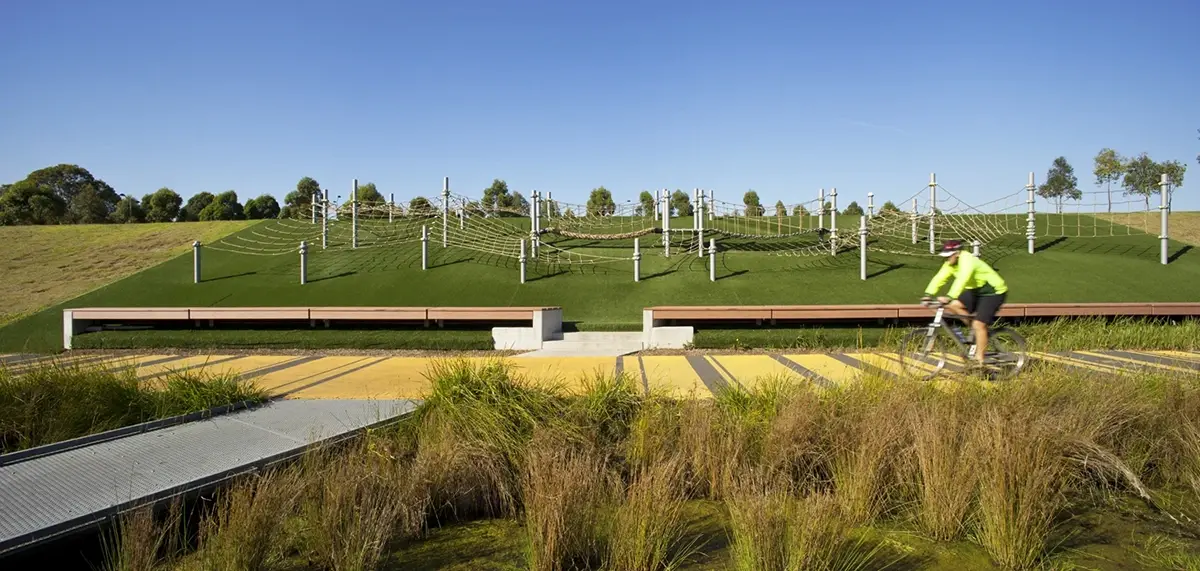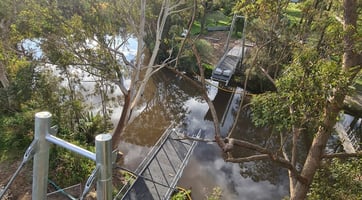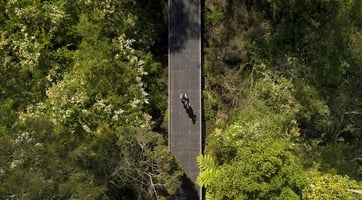Why Active Transport Networks are about so much more than getting from A to B
Active transport networks aren’t merely transport solutions—they’re a powerful means of promoting healthier, more connected communities for generations to come.
The idea of investing public resources into active transport infrastructure projects can be a little polarising, with passionate supporters on both sides.
Here at FORGE we’re unashamedly in the ‘for’ camp. Something we often point out is that most of Australia’s cities already boast expansive cycling and pedestrian corridors that demonstrate the tremendous value that can be gained by adopting a more community-first approach to the way citizens move in and around our towns and cities.
Brisbane is an excellent example, with its active transport infrastructure growing and morphing with the city itself in the past three decades under the stewardship of Brisbane City Council.
Long-established corridors such as the Bicentennial Bikeway along the Brisbane River and the Western Freeway Bikeway stretching deep into the western suburbs from Toowong, have been joined by iconic recent additions including the hugely popular floating Riverwalk connecting New Farm Park to Howard Smith Wharves (and the Felons brewery of course) and the Kingsford Smith Drive bikeway completed in 2019.

New Farm Riverwalk, New Farm QLD (Image by: Chris Olszewski)
However just like similar networks in Sydney, Melbourne and Adelaide, the city’s active transport network is still far from perfect with a number of missing links, amenity gaps and navigation challenges to be found for both pedestrian and cyclists alike.
The great news is there’s enormous potential to fill these gaps and create truly world-class active transport cities across Australia in the years ahead. We’ve seen it happen elsewhere—like in Copenhagen, where almost half the population commutes by bike, or in Paris, where hundreds of streets have been redesigned around people, not cars. Even locally, Sydney’s green link strategies and Melbourne’s Capital City Trail show what’s possible when movement is reframed as a public good rather than a private transaction.
This may sound ambitious, but in reality achieving it doesn’t necessarily require more investment, but rather a more seamless and integrated approach. Just imagine the possibilities if we collectively reframe the role active transport infrastructure can play in a modern and connected city where multi-modal transport is increasingly the norm, rather than the exception.
The community benefits of thinking this way can be enormous and there are certainly many examples in cities around the world—which is why it’s something we’re always exploring here at FORGE for our Australian clients.

Subiaco Creek Bicycle and Pedestrian Link, Rydalmere NSW
What does a successful active transport network look like?
The first thing to say here is it’s about more than simply building new bridges and bike paths, as important as they are of course.
Today’s most loved and connected active transport networks are shaped just as much by the supporting infrastructure that serves them to deliver the optimal mix of amenity, access and safety for all who use them.

Cooks River Crossing, Marrickville NSW
At a practical level, it’s about providing safer and easier-to-navigate routes, accessible ramps and shallow gradients, comfortable shade shelters and seating for taking a well-earned break, thoughtfully-spaced rest stops with toilets and fresh water, and lighting that ensures users feel safe around the clock, year-round.
At a more emotional level, it’s about thinking beyond generic and soulless solutions—rather seizing the wonderful opportunity to use bespoke contextually designed structures to inject added life and energy into local communities, encouraging not just movement, but an invitation to pause, rest and reconnect with their surroundings.

Moncrieff Community Recreation Park, Moncrieff ACT
Multi-generational design.
At FORGE, one of the big trends we’re currently seeing in relation to active transport networks is the adoption of multi-generational design principles.
Not long ago, those using city cycleways were often fitness-driven commuters or weekend enthusiasts. But today, with the rise of e-bikes, scooters and other personal mobility devices, that profile is changing rapidly. Now, it’s essential to design for everyone—families, school children, weekday workers, retirees, and recreational users alike.
We’re not alone in this shift. In the Netherlands, children cycle independently on protected routes designed specifically with their safety and confidence in mind. Older adults benefit from stable infrastructure that accommodates trikes and e-bikes. In Singapore, cycling and pedestrian routes are intentionally designed with the elderly and mobility-impaired in mind, with smooth surfaces, wayfinding and shaded links.
The growing popularity of multi-modal transport is also driving significant design shifts around the world and it’s particularly relevant for a large and sprawling Australian cities. How do we provide infrastructure that better accommodates those who wish to ride from home to their local station before commuting to work or school by train, for example? Similarly with buses, if people can’t actually take their bike or scooter with them (that’s another article entirely!) how can we provide more secure and easily accessible storage options until they return?
As just one example, FORGE was heavily involved in the multi-million-dollar rollout of the Norwest Metro line in Sydney and played a hands-on role in the design and delivery of commuter amenities at Metro train stations for precisely this reason—to make every journey more comfortable and seamless. It’s the kind of design logic also being applied in cities like Vancouver, where secure bike storage at transit hubs has become standard practice.
Norwest Metro, Norwest NSW
The Opportunity Ahead
The logic is simple—when active transport is more appealing, more people choose it, and the entire community reaps the benefits.
There’s enormous opportunity here. The challenge is to embrace it by adopting a community-first design when shaping the future of Australia’s cycling and active transport networks – one that balances movement with experience, and infrastructure with identity.
If you're looking to shape active transport solutions that are not just functional, but truly transformative for your community, let’s talk.





